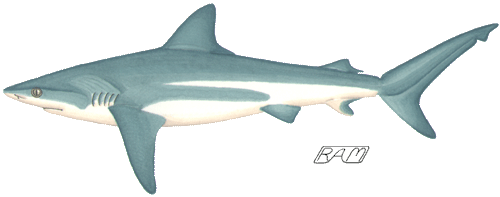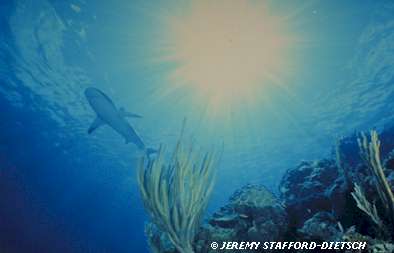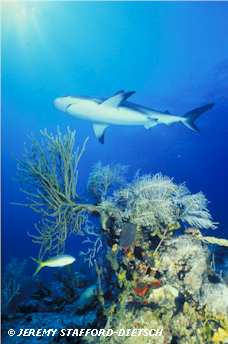Making a Shark Documentary

Caribbean Reef Shark (Carcharhinus perezi)
I just got back from doing one of the neatest things I've ever done. For the past week, I've been in the Bahamas with a British film crew, working on a new shark documentary. Since many SHARK-L participants and lurkers are shark doco aficionados, I thought it might be of interest to learn a bit about how one of these particular thingies is put together.
By the time I was brought on-board this film project, a lot of work had already been done. Tigress Productions, an accomplished film production company — who had made, among other things, the "In the Wild" and "Rough Guide" series — based in London and Bristol, had for several months been working on a new 6-part series called "Predators and People". One of these half-hour programs, the first and most ambitious of them, was to be about sharks. By the time I was contacted, Tigress had already successfully pitched the series to broadcast executives, secured funding for the series and a commitment to air the programs on ITV (a major British broadcasting network).
 Photo © Jeremy Stafford-Deitsch; used with
|
Rachel Spencer, a researcher for Tigress, got my name through DIVER Magazine, a Canadian periodical for whom I formerly wrote and illustrated a highly popular marine life column called "The Diving Naturalist". In April 1999, Rachel rang me, as she had heard that I had "encountered a shark". As I am contacted by an average of three film producers (or wanna-be's) each month, most of whose projects come to nothing, I played it cool: "One or two, yeah". It quickly became apparent to Rachel that I had, in fact, a great deal of experience with sharks in the wild. As part of my on-going research on the behavioral ecology of sharks, I have been fortunate to spend several tens of thousands of hours underwater in the company of about 45 species of sharks, off the shores of nearly 40 countries and under a wide variety of diving conditions. I had also worked as a scientific consultant and writer on several underwater documentaries, and had appeared as an on-camera presenter for one of them (a Discovery Channel film about Pacific White-sided Dolphins, (Lagenorhynchus obliquidens). Much to her credit, Rachel quickly shifted her focus.
Once I became convinced Tigress had the intention, experience and wherewithal to make a good, pro-shark film, I agreed to help as much as my busy schedule would allow (as many of you know, I'm working on a new shark book; as such, I have enormous control over my work schedule but am ill-inclined to stop work on the book without a bloody good reason). Over the course of several E-mails, phone conversations, and a face-to-face meeting with program producer/director Dawn Baresford in San Francisco (facilitated through my good friend and SHARK-L participant, SharkByte — a.k.a. Chris), Tigress came to the conclusion that I — whom they had discovered quite by accident — would make a terrific on-camera 'defender' of sharks. We worked out terms and conditions, and — after a brief distraction writing another couple of chapters — I was off to the Bahamas to film my portion of the programme.
The Bubble Helmet
On 4 July, 1999, I arrived in Nassau, Bahamas, for a week-long shoot. Like so many camera crews before us, we were there to avail ourselves to the almost unique, virtually guaranteed shark action that could be choreographed by Stuart Cove, whose dive operation had introduced many thousands of underwater adventurers to a large resident group of diver-acclimated Caribbean Reef Sharks (Carcharhinus perezi).
As we had discussed, Tigress was particularly keen to interview me underwater. Despite the fact that Dawn and sound-man David Holmes do not dive, this was made possible by virtue of a nifty piece of equipment called a 'bubble helmet'. As the name suggests, the bubble helmet consists of a transparent sphere composed of perspex (a hard, clear, acrylic-like material), sealed via a large O-ring to a weighted metal collar which — in turn — has a built-in demand regulator and a drysuit-like neck seal. With the addition of a headset inside the bubble connected via thin, waterproof cables to surface-bound communications equipment, this apparatus freed me from the usual mouth-plugging scuba regulator and enabled me to speak more-or-less normally, hear instructions from my director Dawn, as well as have my narration recorded with crystal clarity by soundman Dave. From within the bubble helmet's dome, my voice sounded like I was talking with my head inside a toilet bowl, but I had about 270 degrees of clear, unobstructed underwater view.
In order to learn how to use the bubble helmet, Tigress had arranged for the on-site assistance of Jordan Klein, a Florida-based diving equipment expert who — among many other underwater films — had worked on the James Cameron movie "The Abyss" as well as the original 1960's and 1990's "Flipper" television series. After a brief 'get acquainted' dive in the deep end of a hotel swimming pool, during which I practised using the bubble helmet under Jordan's aegis, I was off to narrate my portion of the shark film 14 metres (45 feet) underwater, on a Bahamian reef while numerous Caribbean Reef Sharks swam around my bubble-encased head.
Filming Underwater
But using the bubble helmet in the ocean was not without its logistical challenges. For starters, the helmet requires the user to consume air at a tremendous rate, each breath filling not only his lungs but also the considerable volume inside the bubble. As a result, my air supply consisted of three cylinders of air, hauled around by a safety diver, carrying my air supply like a clunky bridal train.
In order to operate my BCD (inflatable vest which — if used properly — provides neutral buoyancy at depth), I wore on my back a pony bottle (a small air cylinder) dedicated to this purpose. Another problem was clearing my ears. As anyone who has dived or snorkeled knows, the deeper one goes, the more forcefully water pressure pushes in on his ear drum. This pressure can become quite painful if not alleviated by pinching one's nose twixt thumb and forefinger and forcing a tiny quantity of air from the lungs into the Eustachian tubes, thereby equalizing the pressure inside the ear with that outside. Inside the helmet, I could not use my fingers to pinch my nose to relieve this pressure. The inside collar of the helmet did contain a firm rubbery wedge designed to pinch the user's nostrils together without need of hands, but with the underwater headset in place this maneuver was blocked by the microphone in front of and slightly above my mouth. As such, I had to descend very slowly and gingerly, swallowing continually to equalize my ear pressure in tiny increments.
Once on the bottom, other difficulties became apparent. First was the nasty tendency of the helmet to fog up. This was due mostly to the heat generated by the sheer exertion of swimming while wearing the clunky gear. This could be alleviated somewhat by flushing the helmet with cool, dry air from the supply carried by my safety diver. This flushing action also purged the carbon dioxide (CO2) that accumulated steadily inside the bubble due to my exhalations. As it happens, on my first ocean dive using the helmet, I did not flush the accumulated CO2 nearly often enough, as I was concerned about air consumption. I surfaced with one nasty, super-intense CO2 headache — similar to, but far worse than, any hangover I've ever experienced in my younger and wilder marathon drinking days.
But the biggest problem by far is the inherent instability of the helmet apparatus itself. The trapped air inside the bubble was highly and unrelentingly buoyant; to counteract this, the collar held a specially-made 5 or 6-kilogram (11 or 13-pound) weight, pulling my head down with an insistent force of some 50 or 60 Newtons. These opposing forces made it very, very difficult to stand up against even a moderately weak current and well . . . I kept falling over. Signaling to the cameraman, Scott Tibbles, and my various safety divers what was happening, I'd fall helplessly forward or back in horrible slow-motion, over and over again. This happened ten, maybe 15 times — I lost count. I could have become angry or frustrated, I suppose, but I decided to 'roll with it': on the soundtrack being recorded topside, I can clearly be heard laughing heartily like a good humored trooper (or is that a deranged hyena?). Each time I fell over, a safety diver picked me up, planted me on the bottom afresh, and I'd signal the director and soundman topside and the underwater cameraman that I was ready to try again.
 Photo © Jeremy Stafford-Deitsch; used with the gracious permission of the photographer, who asks that you support the Shark Trust. |
While all this was going on, Stuart Cove had been baiting the water all around me with fish parts. About 40 medium- to large-sized Caribbean Reef Sharks — most in the 1.5- to 1.8-metre or 5 to 6-foot range of lengths — swarmed all over me like friendly puppies, brushing against the bubble helmet, bumping my arms and legs, slithering up my front and back. So here I was, surrounded by feeding sharks, a half dozen safety divers, falling over repeatedly like a drunken rag doll, taking cues from a director who could hear but not see me (at one point, I scared the Hell out of Dawn at the surface, who via the com link, heard me grunt followed by a tremendous WHOOSH of air — all that had happened was that a shark had bumped into my ribs just as I was preparing to flush the bubble helmet), and composing what I hoped were intelligible, off-the-cuff responses to challenging questions. But I hung in there, chattily answering Dawn's questions (which were unrehearsed, because she wanted my narrative to be as spontaneous as possible). We got everything Dawn wanted for my underwater interview during a single afternoon, in just two dives.
At the end of the day, pouring over the day's film and sound recording, it all came together beautifully: there I am chatting happily away while dozens of large, feeding sharks swarm all over me, often mere centimetres (inches) away. The coolest thing, visually, is the images of sharks seeming to swim in and out of my ears, as well as the distorted but otherwise crystal clear images of the sharks reflected on both the outer and inner surface of the bubble. The whole thing has a very surreal, M.C. Escher-esque look to it.
The Sharks Themselves
To obtain establishing shots, we did several other dives with the sharks and I also gave several lengthy interviews topside. I am not at liberty to reveal anything about the film's approach or the content of my narrative, but I can pass along a couple of behavioral things I noticed about the sharks while filming.
Due to regularly staged feedings, most of the sharks were diver-acclimated and rather stocky. Although they remained interested in the bait, the Caribbean Reef Sharks fed rather half-heartedly compared with wild sharks. In addition, they did not seem much bothered by being within one anothers' idiosphere (personal space). Agonistic (threat) displays — consisting of a momentary yet stiff and distinctive dipping of both pectoral fins — were strongly muted to non-existent in individuals larger than about 1.5 metres (5 feet), but fairly strongly exhibited by smaller individuals less than 1.2 metres (4 feet) in length. Some of the female sharks bore fresh, white scars on their flanks, some of which were consistent with 'classic' mating scars (on the back between the dorsal fins) while others (over the pectoral fin bases and relatively low on the flanks) were not. According to Stuart Cove's dive staff, the primary mating season for Caribbean Reef Sharks in the area is early- to mid-June. I have been told that sometimes 'sharpnose sharks' (probably Rhiziprionodon terraenovae, but possibly R. porosus) are mixed in among the Caribbean Reef Sharks, but I did not observe this. Other fishes clearly associated with the sharks were, most notably, Yellowtail Snapper (Lutjanus chrysurus) and Crevalle Jacks (Caranx hippos).
At one of the dive sites, all the sharks were adolescent and adult females, while at another about 55% were mature males with the remainder consisting of subadult females. If such an arrangement is typical, this suggests that — as in the closely related Grey Reef Shark (Carcharhinus amblyrhynchos) — juvenile Caribbean Reef Sharks live in mixed-sex social groups until they are about 5 or 6 years old, then the adolescent females strike out on their own to form single-sex, loose aggregations. At no point did I observe true schooling or overt aggression of one individual toward another. Feeding was methodical, with each shark taking its turn and often appearing to nuzzle the feeder/shark wrangler to solicit food or a scratch on top of the head or above the gill slits. Approximately 15% of the sharks observed had physical peculiarities such as permanent injuries or odd pigmentation patterns that allowed confident identification of individuals. From my own observations and discussions with Stuart Cove dive staff, it seems probable that the sharks of a given reef remain fairly site attached and do not often emigrate to join other aggregations.
The Caribbean Reef Sharks were largely bottom associated, seeming reluctant to venture far into the mid-water or near the surface. But some of them could be coaxed to the surface by offerings of food (fish parts), proffered on the end of a metre- (yard-) long barbless feeding spear. When feeding the sharks from the surface, the animals seemed very wary of approaching the boat within 1.5 body lengths. When I donned a mask and snorkel and stuck my face in the water to observe surface feeding, the average approach distance increased by about 50%, suggesting that the animals were further unnerved by my observing them. When, as a simple experiment, I strapped my mask to my foot and dipped it below the surface (attempting to 'track' them as best I could), the sharks did not seem put off by this; donning my mask again and dipping my face in the water once again elicited significantly increased approach distances — which is consistent with my belief that sharks are very aware of a diver's eyes and are rather unnerved by being watched directly. A more formal series of experiments testing this idea seems warranted.
What's Next?
I am deeply flattered that Tigress Productions thought I had something worthwhile to bring to their film. Although it was a lot of hard work — especially working within the bubble helmet — I feel incredibly lucky that I got to do this neat thing.
As I write this, most of the film crew is headed back to England to edit and otherwise complete the film. The film, entitled "Predators and People: Sharks" is scheduled to be broadcast in the UK in February 2000 to a projected audience of about 10 million. It should debut in North America a year or so later. If the film 'works', a great deal of the credit goes to Producer/Director Dawn Baresford, as well as to the many highly skilled people — underwater and topside — who helped me seem far 'better' at my new-found role as TV presenter than I really am.
Dawn assures me that my work in her shark film is so good that — once this program airs — I will undoubtedly be contacted by several other documentary film companies, all eager to work with me on shark-related projects. I hope she's correct in this, as I hope to be able to work on more underwater documentaries. But time will tell one way or another. Ultimately, the only thing that matters is that Dawn is pleased with the resultant film and that — in my own small way — I was able to spread a little pro-shark PR via one of the most powerful mass media available on this planet. I don't much care about any 15 minutes (or whatever) of 'fame'. All I care about is doing good work. Next time I have opportunity to spread my pro-shark message via a TV documentary, I will strive to do even better than I did this time round.
Originally, it was planned that the film crew and I next travel to South Africa to perform a series of experiments I designed to test the sensory, exploratory, and cognitive capabilities of the White Shark (Carcharodon carcharias). But "Predators and People" series producer, Andrew Jackson, likes my ideas so much, he wants to dedicate several months' filming — possibly in several countries around the globe — to a one-hour, stand-alone documentary about White Shark behavior, a kind of exploration 'inside' the mind of this spectacular and much mythologized animal. We are tentatively scheduled to begin planning and pitching our film in earnest in September 1999. If the high competence exhibited by Tigress' film crew on this project is anything to go by, I am confident that the resultant film will challenge many long-standing ideas about the White Shark, presenting the viewer with images and ideas quite unlike anything that has been broadcast before. It promises to be one helluvah Fish Story. If enough of you are interested, I'll keep you posted via SHARK-L.
In any case, I hope you've found this post of interest.
Posted to SHARK-L, 11 July 1999
